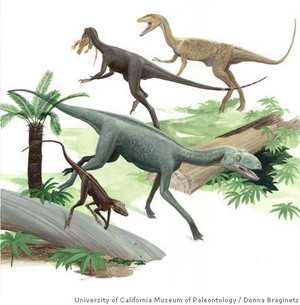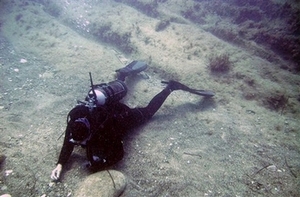A faint star in the Ophiuchus constellation drew about 30 astronomers from around the globe Friday to Columbia Basin College in Pasco.
Molly Bentley
BBCSat, 21 Jul 2007 23:44 UTC
A key US space agency (Nasa) satellite important for detecting hurricanes and providing other climate data will go silent in the next few years, and missions to replace it have been cancelled or delayed.
PASADENA, Calif. - Mission scientists worry that nearly a month's worth of storms could permanently damage or disable the Mars rovers exploring the Red Planet.
UC Berkeley scientists, digging deep into a remote New Mexico hillside, have discovered a trove of fossil bones that they say is evidence that dinosaurs and their early relatives lived side by side for tens of millions of years before the relatives slowly died off and left the dinosaurs to dominate the ancient world.

|
| ©University of California Museum of Paleontology
|
| Dinosaur precursors (from bottom) Dromomeron romeri and a silesaurus-like animal, and dinosaurs Chindesaurus bryansmalli and a coelophysoid theropod.
|
George Psyllides, Associated Press Writer
Yahoo NewsSat, 21 Jul 2007 10:05 UTC
AKAMAS, Cyprus - Archaeologists excavating the seabed off Cyprus have discovered the tools of ancient mariners, which they believe were used by foragers more than 10,000 years ago - before the island had permanent settlements.

|
| ©AP
|
| A diver searches the Aspros area for ancient artifacts off the western coast of Cyprus
|
Thailand will have a close encounter with an asteroid expected to move closer to the Earth than the moon in the next 29 years, according to a prominent astronomer Worawit Tanwutthibundit. The asteroid, named 99942 Apophis, will come into close orbit with the Earth 22 years from now and it will come by again, even closer, seven years after that.
This has sparked fears over the possibility that it could collide with the Earth.
Tony Long
WiredSat, 21 Jul 2007 05:46 UTC
1862: American astronomer Lewis Swift discovers the presence of a large comet that will soon bear his name. Three days later, another American astronomer, Horace Tuttle, makes the same sighting. So this heavenly body comes down to us as the Comet Swift-Tuttle.
Based on their observations, and those of other astronomers who began tracking the comet's highly elongated orbit, it was calculated that Swift-Tuttle would make its next appearance during the 1980s. They were close. Japanese astronomer Tsuruhiko Kiuchi rediscovered the comet in 1992.
The University of Arizona-based High Resolution Imaging Experiment (HiRISE) group this week released a good look at a dust devil on Mars. This is not the storm bedeviling NASA's Mars Exploration Rovers, Spirit and Opportunity.
The HiRISE camera captured the dust twister by chance in its photographic swath of a region in the southern hemisphere near Hellas Planitia during a Martian mid-afternoon early last month. The HiRISE camera is orbiting the Red Planet on NASA's Mars Reconnaissance Orbiter.
Geology detectives in Saskatchewan might have made two important discoveries this summer.
And, as it usually happens for members of the multi-university partnership Prairie Meteorite Search, the finds have come from unexpected places.
When farmer Ken Wiggins heard that field researcher Nathan Seon was coming to talk about meteorites with locals near Wiggins' home base of Manor, he figured there wasn't any harm in having Seon examine an odd-shaped depression that had been on the farm as long as anyone could remember.
NASASat, 21 Jul 2007 03:10 UTC
Scientists have recently discovered that the planet Saturn is turning 60 - not years, but moons.
"We detected the 60th moon orbiting Saturn using the Cassini spacecraft's powerful wide-angle camera," said Carl Murray, a Cassini imaging team scientist from Queen Mary, University of London. "I was looking at images of the region near the Saturnian moons Methone and Pallene and something caught my eye."
The newly discovered moon first appeared as a very faint dot in a series of images Cassini took of the Saturnian ring system on May 30 of this year. After the initial detection, Murray and fellow Cassini imaging scientists played interplanetary detective, searching for clues of the new moon in the voluminous library of Cassini images to date.
The Cassini imaging team's legwork paid off. They were able to locate numerous additional detections, spanning from June 2004 to June 2007. "With these new data sets we were able to establish a good orbit for the new moon," said Murray. "Knowing where the moons are at all times is important to the Cassini mission for several reasons."
Comment: Congratulations, Saturn. You've just got your new comet...eh, moon.
From:
Forget About Global Warming: We're One Step From Extinction!Now let's time travel back to the future, and see what the
latest information tells us about Jupiter's moons:
Jupiter is now given 63 satellites. Forty-seven of those satellites have been discovered since 1999. What if they weren't there before?
What about Saturn. Our 1975 text tells us that Saturn has 10 satellites. In 2007? Well, there are so many that
one source declines to give a precise number!
However, counting the named satellites on the
Timeline of discovery of solar system planets and their natural satellites gives us a count of 62, with 41 being discovered since 2000 and another ten in the 80's and 90's.
Moving outward, we come to Uranus, given five satellites in 1975, it now has 28, with ten being discovered in the 1980's, six in the 90's, and 7 since 2000.
Neptune had two satellites in 1975, now it has 13.
| Planet
|
1975
|
2005
|
Jupiter
|
9
|
63
|
Saturn
|
10
|
62
|
Uranus
|
5
|
28
|
Neptune
|
2
|
13
|
Table 1. Number of moons The explanation given most often to explain this surge in the numbers of satellites for these planets is that telescopes have gotten better. That is, we can see further, with greater detail, and can therefore find things that we couldn't see before. It is an explanation that makes sense. One small problem with this theory is that the "new" moons of Neptune and Uranus showed up before the new moons of Jupiter and Saturn. One would think that powerful telescopes capable of finding moons as far away as the seventh and eighth planets would have found the hard to see moons of the fifth and sixth first.
Another possible explanation, and one which fits with new moons appearing around Neptune and Uranus prior to appearing around Jupiter and Saturn, is that these new moons, or some of them, are objects that have been trapped into orbits around these planets only recently, that they were captured by the gravity of these planets and removed from the incoming comet cloud. Passing the orbits of the outer planets first, they would arrive at the inner planets afterward.
We also note that the much derided Immanuel Velikovsky, in his book
Worlds in Collision, gives a time frame of nine years as the time it would take for a comet to cover the distance between Jupiter and Earth. The new Jovian moons were discovered beginning in the late nineties.
Do the math.


Comment: Congratulations, Saturn. You've just got your new comet...eh, moon.
From: Forget About Global Warming: We're One Step From Extinction!
Now let's time travel back to the future, and see what the latest information tells us about Jupiter's moons: What about Saturn. Our 1975 text tells us that Saturn has 10 satellites. In 2007? Well, there are so many that one source declines to give a precise number!
However, counting the named satellites on the Timeline of discovery of solar system planets and their natural satellites gives us a count of 62, with 41 being discovered since 2000 and another ten in the 80's and 90's.
Moving outward, we come to Uranus, given five satellites in 1975, it now has 28, with ten being discovered in the 1980's, six in the 90's, and 7 since 2000.
Neptune had two satellites in 1975, now it has 13.
Table 1. Number of moons
The explanation given most often to explain this surge in the numbers of satellites for these planets is that telescopes have gotten better. That is, we can see further, with greater detail, and can therefore find things that we couldn't see before. It is an explanation that makes sense. One small problem with this theory is that the "new" moons of Neptune and Uranus showed up before the new moons of Jupiter and Saturn. One would think that powerful telescopes capable of finding moons as far away as the seventh and eighth planets would have found the hard to see moons of the fifth and sixth first.
Another possible explanation, and one which fits with new moons appearing around Neptune and Uranus prior to appearing around Jupiter and Saturn, is that these new moons, or some of them, are objects that have been trapped into orbits around these planets only recently, that they were captured by the gravity of these planets and removed from the incoming comet cloud. Passing the orbits of the outer planets first, they would arrive at the inner planets afterward.
We also note that the much derided Immanuel Velikovsky, in his book Worlds in Collision, gives a time frame of nine years as the time it would take for a comet to cover the distance between Jupiter and Earth. The new Jovian moons were discovered beginning in the late nineties.
Do the math.